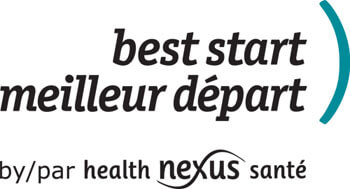| 10 | 10-12 months | Safe environments | Did you know that a safe environment will help your baby’s brain development? |
For healthy development, babies need the safety and freedom to explore. As parents, it’s up to us to provide a safe space both indoors and outdoors.
- Actively supervise children. This means that, at all times, you are watching your child. Stay close enough to prevent accidents from happening.
- When supervising children, avoid distractions such as cell phones and television. Many injuries are caused by distractions due to technology.
- Ensure your baby equipment meets current Health Canada consumer product safety standards.
- Babies learn by putting things in their mouth. Get down at their level and remove any small items they may be able to find.
- Childproof potential hazards, like stairs, electrical outlets, sharp corners on furniture and so on.
- Keep all products which could be poisonous locked up and out of reach of children (cleaning products, medication, cosmetics, cigarettes, etc.).
- Ensure all ropes and cords are out of reach of small children (curtain or window blind cords, electrical cords, strings on clothing, etc.).
- Keep small items such as magnetic toys and jewelry away, out of reach of small children. Some costume jewelry and other metal items, such as key chains, may contain dangerous levels of lead. Do not allow your child to put such items in their mouth.
- Phthalates (chemical plasticizers that may disrupt hormones) were banned from children’s toys in 2010. If you have older soft plastic toys, such as teethers, vinyl books and bath toys, put them in the garbage.
- Keep lighters, matches and candles out of reach.
- Reduce your use of harmful household products such as pesticides, chemicals, harsh cleaning products, air fresheners, paints, fragranced laundry products, certain plastics such as vinyl, etc. These items may contain harmful or poisonous chemicals. Babies and children are more at risk than adults. Consider using baking soda or vinegar to clean.
- Frequent dusting will reduce your child’s exposure to toxic chemicals that settle into regular house dust. It is best to wet-mop, vacuum with a good-quality vacuum cleaner and dust with a damp cloth.
- Make sure the television and electronic equipment are placed securely and anchored properly. Never place these on a dresser because young children could use the drawers like stairs to access the buttons.
- Play outside with your child every day. Take advantage of public play locations such as playgrounds.
- Be especially cautious when you are near swimming pools, lakes and rivers. You should always be within arms’ reach.
- EarlyON Child and Family Centres provide great locations for indoor play. They may also offer outdoor play equipment.
Allow your child the freedom to be active, to run and play in a safe environment.
Links
- Home Safety. Parachute.
- Consumer Product Safety. Health Canada.
- Creating Healthy Home Environments for Kids: Top 5 Tips (video). Canadian Partnership for Children’s Health and Environment.
